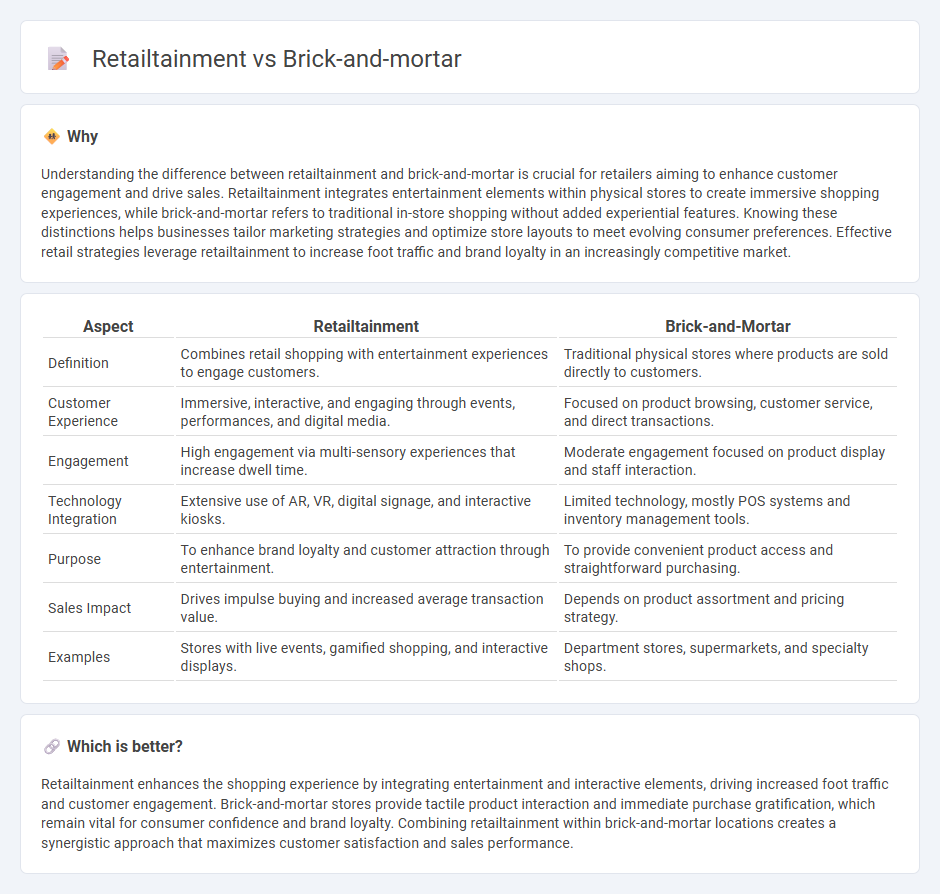
Retailtainment merges entertainment with shopping, creating immersive experiences that drive customer engagement and extend visit duration in physical stores. Unlike traditional brick-and-mortar retail, which focuses primarily on product display and sales, retailtainment integrates interactive elements such as live events, augmented reality, and personalized services to enhance consumer satisfaction. Explore how retailtainment transforms the retail landscape and boosts foot traffic by blending pleasure with purchasing.
Why it is important
Understanding the difference between retailtainment and brick-and-mortar is crucial for retailers aiming to enhance customer engagement and drive sales. Retailtainment integrates entertainment elements within physical stores to create immersive shopping experiences, while brick-and-mortar refers to traditional in-store shopping without added experiential features. Knowing these distinctions helps businesses tailor marketing strategies and optimize store layouts to meet evolving consumer preferences. Effective retail strategies leverage retailtainment to increase foot traffic and brand loyalty in an increasingly competitive market.
Comparison Table
| Aspect | Retailtainment | Brick-and-Mortar |
|---|---|---|
| Definition | Combines retail shopping with entertainment experiences to engage customers. | Traditional physical stores where products are sold directly to customers. |
| Customer Experience | Immersive, interactive, and engaging through events, performances, and digital media. | Focused on product browsing, customer service, and direct transactions. |
| Engagement | High engagement via multi-sensory experiences that increase dwell time. | Moderate engagement focused on product display and staff interaction. |
| Technology Integration | Extensive use of AR, VR, digital signage, and interactive kiosks. | Limited technology, mostly POS systems and inventory management tools. |
| Purpose | To enhance brand loyalty and customer attraction through entertainment. | To provide convenient product access and straightforward purchasing. |
| Sales Impact | Drives impulse buying and increased average transaction value. | Depends on product assortment and pricing strategy. |
| Examples | Stores with live events, gamified shopping, and interactive displays. | Department stores, supermarkets, and specialty shops. |
Which is better?
Retailtainment enhances the shopping experience by integrating entertainment and interactive elements, driving increased foot traffic and customer engagement. Brick-and-mortar stores provide tactile product interaction and immediate purchase gratification, which remain vital for consumer confidence and brand loyalty. Combining retailtainment within brick-and-mortar locations creates a synergistic approach that maximizes customer satisfaction and sales performance.
Connection
Retailtainment enhances the brick-and-mortar shopping experience by integrating entertainment elements that attract and engage customers, leading to increased foot traffic and longer store visits. This fusion boosts sales and brand loyalty by creating memorable, interactive experiences beyond traditional retail transactions. Retailers leverage technology, live events, and immersive displays to transform physical stores into dynamic social hubs, differentiating themselves from online competitors.
Key Terms
Physical Store Experience
Brick-and-mortar stores are evolving beyond traditional shopping by integrating retailtainment elements such as interactive displays, live events, and immersive environments to enhance customer engagement. These physical store experiences leverage sensory and social interactions to create memorable visits that drive foot traffic and increase sales. Discover how combining retailtainment with brick-and-mortar strategies can transform your store into a dynamic destination.
Experiential Retail
Experiential retail transforms traditional brick-and-mortar stores by integrating interactive elements such as virtual reality, live events, and personalized services to enhance customer engagement and drive foot traffic. Retailtainment creates immersive shopping environments that encourage social interaction and brand loyalty, blending entertainment with commerce to meet evolving consumer expectations. Discover how leading retailers leverage experiential strategies to redefine in-store experiences and boost sales.
Customer Engagement
Brick-and-mortar stores leverage tangible product experiences and personalized service to enhance customer engagement, creating immersive environments that foster brand loyalty. Retailtainment combines shopping with entertainment, using interactive displays, events, and technology-driven experiences to captivate customers and increase dwell time. Explore how integrating both strategies can transform retail engagement and drive sustained consumer interest.
Source and External Links
Brick and mortar - Wikipedia - A brick-and-mortar business refers to a company with a physical presence in a building, such as retail shops or warehouses, contrasting with online-only businesses that lack a storefront for face-to-face customer interaction.
BRICK-AND-MORTAR definition | Cambridge English Dictionary - The term is used to describe traditional businesses that operate in a physical building, as opposed to those operating solely on the internet.
Brick & Mortar - St. Petersburg Restaurants - Tripadvisor - Brick & Mortar is also the name of a well-known cozy restaurant in St. Petersburg, Florida, praised for its quality food and atmosphere, unrelated to the business term.
 dowidth.com
dowidth.com